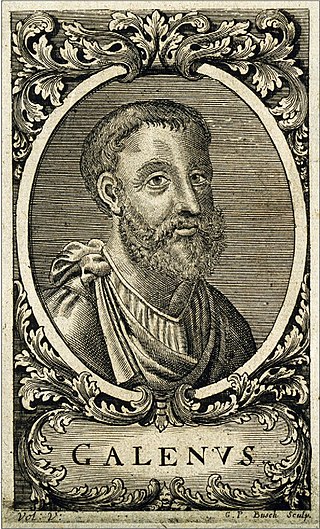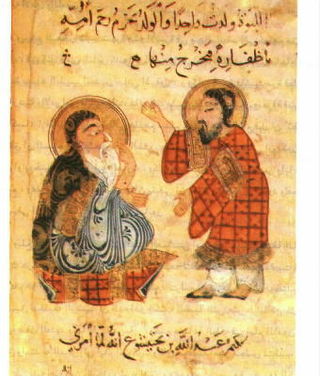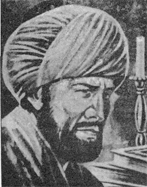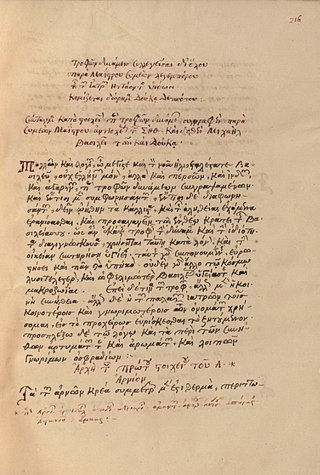
Aelius Galenus or Claudius Galenus, often anglicized as Galen or Galen of Pergamon, was a Roman Greek physician, surgeon and philosopher. Considered to be one of the most accomplished of all medical researchers of antiquity, Galen influenced the development of various scientific disciplines, including anatomy, physiology, pathology, pharmacology, and neurology, as well as philosophy and logic.

Nicephorus Gregoras was a Byzantine Greek astronomer, historian, and theologian. His 37-volume Byzantine History, a work of erudition, constitutes a primary documentary source for the 14th century.

Abu Sa'id 'Ubayd Allah ibn Bakhtishu (980–1058), also spelled Bukhtishu, Bukhtyashu, and Bakhtshooa in many texts, was an 11th-century Syriac physician, descendant of Bakhtshooa Gondishapoori. He spoke the Syriac language. He lived in Mayyāfāriqīn.

In the history of medicine, "Islamic medicine" is the science of medicine developed in the Middle East, and usually written in Arabic, the lingua franca of Islamic civilization.
Praxagoras was a figure of medicine in ancient Greece. He was born on the Greek island of Kos in about 340 BC. Both his father, Nicarchus, and his grandfather were physicians. Very little is known of Praxagoras' personal life, and none of his writings have survived.

Byzantine medicine encompasses the common medical practices of the Byzantine Empire from c. 400 AD to 1453 AD. Byzantine medicine was notable for building upon the knowledge base developed by its Greco-Roman predecessors. In preserving medical practices from antiquity, Byzantine medicine influenced Islamic medicine and fostered the Western rebirth of medicine during the Renaissance.

Uroscopy is the historical medical practice of visually examining a patient's urine for pus, blood, or other symptoms of disease.
Johannes Zacharias Actuarius, son of Zacharias, was a Byzantine physician in Constantinople. He is given the title of Actuarius, a dignity frequently conferred at that court upon physicians.

Abū Jaʿfar Aḥmad ibn Ibrāhīm ibn Abī Khālid ibn al-Jazzār al-Qayrawani (895–979), was a 10th-century Muslim Arab physician who became famous for his writings on Islamic medicine. He was born in Qayrawan in Tunisia. He was known in Europe by the Latinized name Algizar.

Shabbethai Donnolo was a Graeco-Italian Jewish physician, and writer on medicine and astrology.

Symeon Seth was a Byzantine scientist, translator and official under Emperor Michael VII Doukas. He is often said to have been Jewish, but there is no evidence of this. He wrote four original works in Greek and translated one from Arabic.

Scientific scholarship during the Byzantine Empire played an important role in the transmission of classical knowledge to the Islamic world and to Renaissance Italy, and also in the transmission of Islamic science to Renaissance Italy. Its rich historiographical tradition preserved ancient knowledge upon which splendid art, architecture, literature and technological achievements were built. Byzantines stood behind several technological advancements.
Nakoleia also known as Nakolaion (Νακώλαιον), Latinized as Nacolia or Nacolea, was an ancient and medieval city in Phrygia. It corresponds to present-day Seyitgazi, Eskişehir Province in the Central Anatolia region of Turkey.

The Cyranides is a compilation of magico-medical works in Greek first put together in the 4th century. Latin and Arabic translations also exists. It has been described as a "farrago" and a texte vivant, owing to the complexities of its transmission: it has been abridged, rearranged, and supplemented. The resulting compilation covers the magical properties and practical uses of gemstones, plants, and animals, and is a virtual encyclopedia of amulets; it also contains material pertinent to the history of western alchemy, and to New Testament studies, particularly in illuminating meanings of words and magico-religious practices. As a medical text, the Cyranides was held in relatively low esteem even in antiquity and the Middle Ages because of its use of vernacular language and reliance on lore rather than Hippocratic or Galenic medical theory.
Demetrios Chloros was a 14th-century Byzantine physician, astrologer, priest and sorcerer who was tried for possessing magic books.
Nikephoros Choumnos was a Byzantine scholar and official of the early Palaiologan period, one of the most important figures in the flowering of arts and letters of the so-called "Palaiologan Renaissance". He is notable for his eleven-year tenure as chief minister of emperor Andronikos II Palaiologos, his intense intellectual rivalry with fellow scholar and official Theodore Metochites, and for building the monastery of the Theotokos Gorgoepēkoos in Constantinople.
Amīn al-Dawla Abu'l-Ḥasan Hibat Allāh ibn Ṣaʿīd ibn al-Tilmīdh was a Christian Arab physician, pharmacist, poet, musician and calligrapher of the medieval Islamic civilization.

Greece played a crucial role in the transmission of classical knowledge to the Islamic world. Its rich historiographical tradition preserved Ancient Greek knowledge upon which Islamic art, architecture, literature, philosophy and technological achievements were built. Ibn Khaldun once noted; The sciences of only one nation, the Greeks, have come down to us, because they were translated through Al-Ma'mun’s efforts. He was successful in this direction because he had many translators at his disposal and spent much money in this connection.
Barbara Zipser is a Historian of Greek medicine from antiquity to the Middle Ages. She is currently Senior Lecturer at Royal Holloway, University of London. Her research has been primarily funded by the Wellcome Trust.
In the Byzantine Empire, cities were centers of economic and cultural life. A significant part of the cities were founded during the period of Greek and Roman antiquity. The largest of them were Constantinople, Alexandria, Thessaloniki and Antioch, with a population of several hundred thousand people. Large provincial centers had a population of up to 50,000. Although the spread of Christianity negatively affected urban institutions, in general, late antique cities continued to develop continuously. Byzantium remained an empire of cities, although the urban space had changed a lot. If the Greco-Roman city was a place of pagan worship and sports events, theatrical performances and chariot races, the residence of officials and judges, then the Byzantine city was primarily a religious center where the bishop's residence was located.












